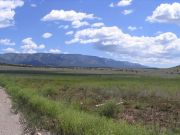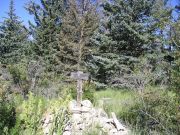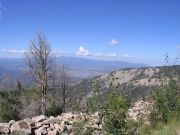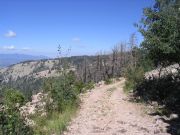
The Mountains of New Mexico
www.surgent.net |
| Capitan Mountain |
• Capitan (Sacramento) Mountains • Lincoln National Forest • Lincoln County |
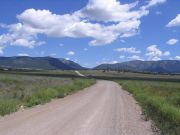 Capitan Gap |
Date: August 8, 2007
• Elevation: 10,201 feet
• Prominence: 3,261 feet
• Distance: 5.5 miles
• Time: 2 hours
• Gain: 1,200 feet
• Conditions: Clear and nice, but the humidity was noticeable
New Mexico
•
PB
After my hikes in the Sacramento Range, I drove from Alamogordo through Carrizozo and east another 20 miles through the hills to the own of Capitan, arriving at 3 p.m. in rainy weather. Capitan has only one hotel, the Smokey Bear Lodge, and I took a room there for two nights, seeing it as a good place to fan out for the three peaks I had next on my list. I didn't do much for the rest of the day other than relax, watch the tube and read. At sunset, the clouds parted and the storms started to die down, resulting in spectacular conditions and beautiful colors. I set up my camp chair outside my room and sat and enjoyed the pleasant temperatures.
On my agenda today was the summit of the Capitan Mountains, located north of town. The Capitans are famous for a forest fire that swept the range in 1950, and the discovery of a small bear cub, injured in the blaze, that was nursed to health and who became the famed Smokey Bear symbol for forest fire prevention (note: it is "Smokey Bear", not "Smokey the Bear"). The bear lived until the mid-1970s at the National Zoo in Washington, D. C., and was buried back here in Capitan after his death. Capitan the town capitalizes on this theme, with many places in town named for the bear, and a museum in the heart of town that is worth a quick visit.
The range is essentially one large massif, a granite intrusive body above the sedimentary plains below. It is one of the rare ranges to run east-west, and its ridge features very little variation. Its peaks and subpeaks barely rise a hundred feet above the ridgeline. Capitan Peak, at 10,083 feet, is a popular hiking destination, a small hill on the range s east tip. However, the summit of the range is another small hill on top the range at 10,201 feet. Apparently it is called Palko Peak, but this name is never mentioned on any maps.
The range is crossed length and breadth by trails, offering options to access the highpoint. Steep routes go from the plains to Capitan Peak, then a long ridge trail (called the Summit Trail) leads to the highpoint. However, this would have entailed at least 16-18 miles of hiking, and significant time high on the ridges which was out of the question given the weather pattern lately. Instead, I looked at a service road that works its way high onto the range crest from the west through Capitan Gap. Assuming I could get the truck in most of the way, I would be left with a relatively short hike to the highpoint. I hoped the road was in reasonable condition.
From Capitan, I went east on US-380 for two miles to the Capitan Gap Road (Road C-1), and for the first 5.3 miles it was a wide gravel road that worked its way through rolling rangeland of grasses and glens of pinon and juniper. At the 5-mile mark it drops into a small private inholding featuring a run-down home with dozens of old vehicles in the yard. Soon, I crossed into Forest property. The good road turns right to a Bible Camp, while the road to Capitan Gap continues north, now called Lincoln National Forest Road 56. This is decent road, gaining through moderate forest to Capitan Gap, 6.9 miles from the highway.
I stayed right and then started up the steep grades, putting the truck into 4-wheel drive. The road is quite steep for the next two miles, but in pretty good shape and wide, too. Afterwards it gains the main range crest, where the gradient is gentler, features a few ups and downs and with pretty meadows. Padilla Point is about 5 miles up from Capitan Gap, and probably the last best place to camp, for afterwards the road lessens in quality and becomes more rocky and steep. Where the road runs north of the summit of "Summit Spring" near the Corral Canyon sign, the rocks become rather bad. I managed to bash and smash my truck down to a saddle at elevation 9,572 feet, where I parked, 7.2 miles from Capitan Gap. This put me about 1.7 miles from the end of the road, but in retrospect (had I known about this section of road) I would have parked farther back and walked this stretch. In any case, I was where I was, and ready to go.
I hiked the road, gaining gently on the south face of the range crest. It was still early enough so that I had shade. In about 30 minutes, I had covered 1.7 miles to the end of the road, at with the Summit Trail (Trail 58). From here, I walked down the switchbacks hewn into the talus, an impressive feat of "moving rocks aside" in order to create the trail. From here to the highpoint is just over a mile, in which the trail drops about 200 feet, then regains about 125 feet to top out on a small intermediate bump (the map is incorrect here: the trail goes right over the top, not to the side). Then another drop of about 80 feet, and the final push to the actual summit. The trail is pretty good, but overgrown, suggesting it probably doesn t see a lot of hikers.
As I arrived near the actual highpoint, I left the trail and went cross-country through knee-high grass, coming to the summit after a few minutes. The top is rocky with a cairn and a sign, where I learned the summit is called Palko Peak, and some simple rock benches. However, the place was buzzing and crawling with insects, and a small gopher snake scooted away as I came upon him. I wasn t too motivated to stick around, so I only stayed long enough for a photo and to look around. Views from here are mostly of the nearby trees.
Hiking down, I found the trail quickly, then worked my way back to my truck, for an overall journey of three hours. I enjoyed the views down into the valleys below, unimpeded by foothills. The drive out was bumpy and nasty as I re-negotiated that last section, then nicer once past it. I didn t realize how steep the road was as I descended into Capitan Gap, but it is, and exposed too, although still wide and well-maintained. The views were stunning. This hike not only had a fun walking portion to it, but the driving part of the hike was just as fun. I enjoyed it thoroughly. Since the town was so close, I was back to my hotel by 10:30 a.m., still a whole day to kill. What should I do with all my free time? Join a gang? Hike another peak?
The weather was holding up better than yesterday. Puffy clouds were starting to develop but none had yet turned into thunderheads yet. Of the remaining two peaks on my agenda, Carrizo Peak was closer, but Gallinas Peak, about 50 miles north, was quicker logistically, and given the potential for afternoon storms, I chose to save Carrizo Peak for the next morning and spent the better part of this afternoon visiting Gallinas Peak.
|
|
